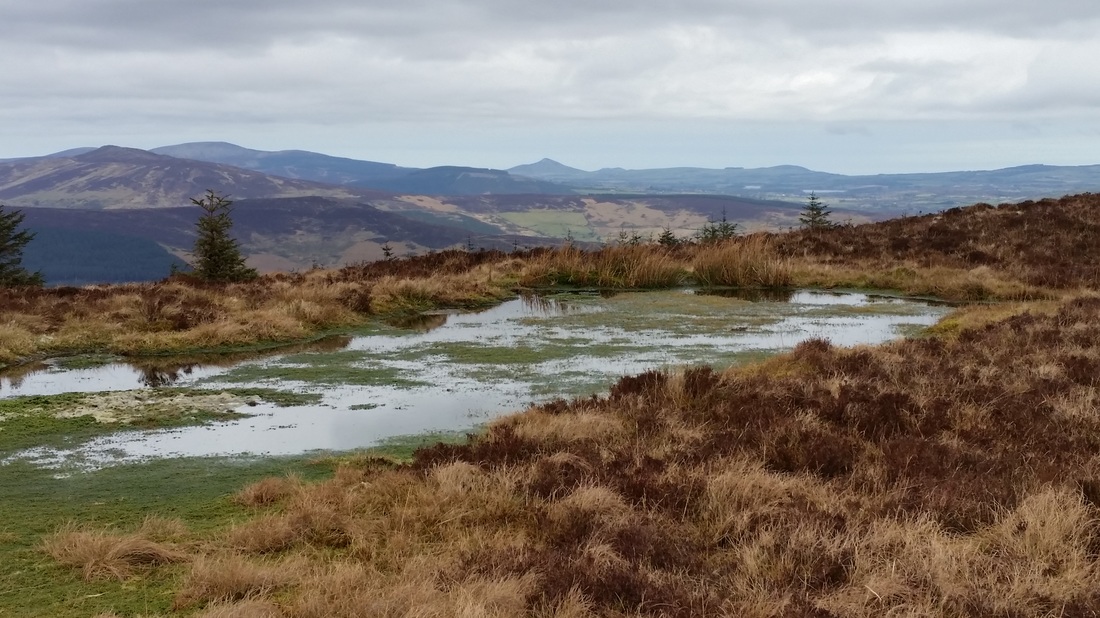Hike #2 also began from Glendalough), but this time went south of the monastic ruins (I’ll talk about the Glendalough monastery next time). We hiked for about 9 miles in 5 hours, climbing through the bogs of Derrybaun Mountain to Mullacor and descended to the Spinc, a bluff trail that edges the bluff high above Glendalough’s mountain lakes.
I’m slowly learning about bog plants and Wicklow Mountain wildlife. Only sphagnum mosses grow in the actual bog pools. Not only are they one of the few plants that can survive the wet environment, but they also turn the water acidic so that no other competitor plants could grow there. As these mosses die off each season, they only partly decay in the anaerobic water, and the partially decayed plant matter builds up season after season forming peat, which when cut, dried, and burned, is called turf, which used to be burned like firewood. Indeed, any organic matter tossed into the bog—including ancient “bog bodies”—never fully decays.
But there’s lots of life as well! Frogs like the bog. Tom scooped handfuls of frog eggs for us and commented on their developmental stages.
Sedges and rushes are two other kinds of bog and upland plants. Tom taught me the difference between the two: Rushes are Round and Sedges have Edges! The tubular rushes—used in making thatched roofs—remind me of horsetail plants without the segmentation. Sedges are grasses that grow in small clumps.
Wildlife in the bog and wet uplands includes foxes and mountain hares and peregrine falcons. The Irish mountain hare was thought to be a subspecies of the continental mountain hare, because the Irish version did not turn white in winter. Until a few years ago, that is, when a succession of hard winters brought more snow than usual to the mountains and turned the Irish hares white for the first time since biologists had recorded them. Scientists were amazed and had to reclassify the hare as being the same as the continental version. But if scientists were surprised, what about the hares?! They must’ve thought they’d all gone prematurely grey!
In the end, though, it is the history of the Wicklows that most amazes me. One quick story: In 1592, Irish rebels Art O’Neill and Red Hugh O’Donnell escaped from a British prison in Dublin Castle on Christmas Eve, made their way through town, and then, under cover of darkness fled up into the Wicklow Mountains toward the stronghold of the rebellious O’Neill clan. But Art had been more severely weakened by imprisonment than the younger Hugh, and he died during the night on a mountainside in view of our hike.
Dubliners still commemorate his escape with a 53-kilometer charity hike from Dublin Castle to the Wicklow Mountains every January!
The Wicklow Mountains were both bane and refuge for Irish rebels over the years. In the end, the British resorted to building military roads and barracks in the mountains, and deforesting the landscape (no hiding in the trees) to try to scout them out.
Even during the Civil War that followed independence, the Wicklows became a hideout for republicans who wanted to fight on to include Northern Ireland in the Republic. In 2012 I went bicycling by myself in the Wicklow Mountains, and off in the distance along a mountain road I noticed a monument halfway up the mountainside and a pathway leading to it. Curious, I dropped my bike and walked up the pathway, only to discover a monument to a republican fighter, a member of the IRA, who had been murdered at that site by his own countrymen who had undoubtedly fought at his side for independence.
Ireland isn’t my home country, but I couldn’t help feeling the loneliness of that place, far from any human companions.
Nothing fully disappears in the bog. Memory always lingers on.
